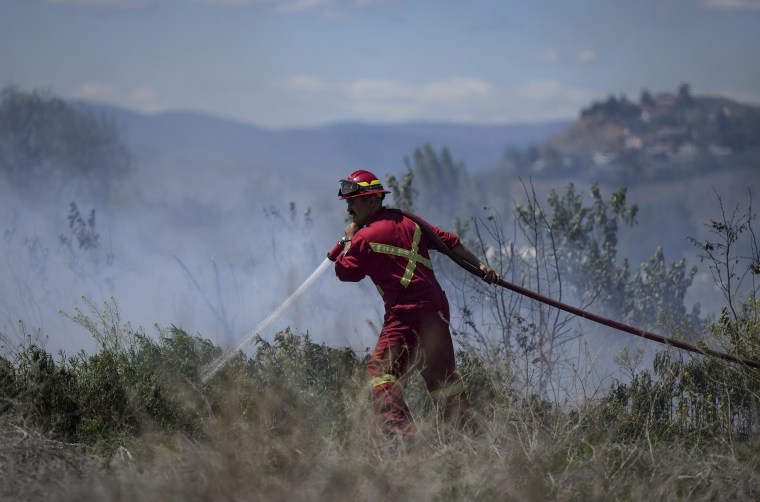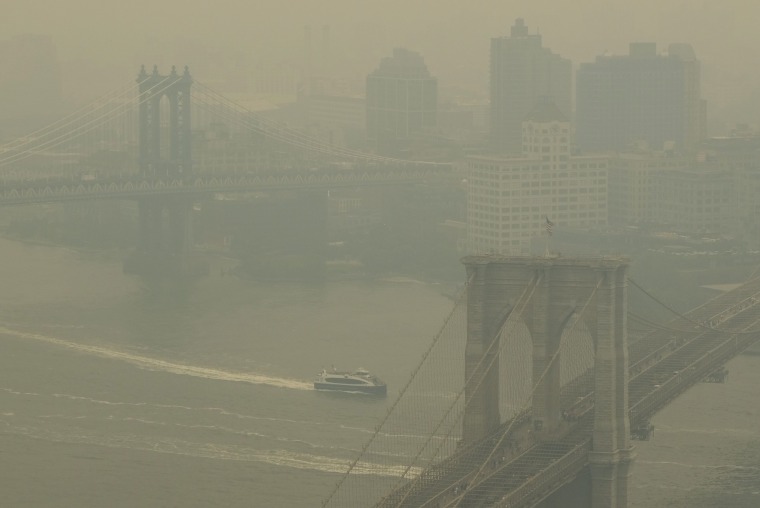Don’t go outside.
That’s what public health officials and medical experts have been advising tens of millions of people in the U.S. over the last couple of days as smoke from raging wildfires in Canada has drifted into the U.S., triggering air alerts and grounding flights across the Northeast, as far south as South Carolina and as far west as Minnesota.
Canada experiences wildfires regularly, but fires this season have been unusually widespread and intense, with more than 1400% of the normal number of acres burned for this time of the year, according to ABC News. Tens of thousands of Canadians have been displaced from their homes. And Stanford researchers have found that the resulting smoke has already produced one of the worst wildfire pollution events in U.S. history.
Many people in the eastern U.S. are experiencing threats to their health that are typically associated with the wildfire-prone West Coast, and wondering whether the smoke they are seeing and smelling could become the new normal. I emailed Michael Mann, a professor of atmospheric science at Penn State and the author of “The New Climate War: The Fight to Take Back Our Planet,” to ask him for his analysis of the wildfire crisis, the dangers it poses and its links to climate change. Our correspondence, edited for length and clarity, follows.
Zeeshan Aleem: Could you give us some context on why the wildfires in Canada are so intense? What caused this situation?
Michael Mann: We have a very extreme, slow, wavy jet stream pattern right now over North America, leading to an extended period of unusually dry weather over parts of Ontario and Quebec, which has favored the development of these wildfires. The current pattern dips way north and south, meanders like a river as it crosses the U.S., with a huge dip from eastern Canada down into the eastern U.S. The stuck jet stream pattern is responsible for the dry conditions in eastern Canada and also the wind patterns that are transporting that wildfire smoke toward us in the U.S. Our own research suggests that climate change is making these slow, wavy summer jet stream patterns more common.
There are several things going on, each of which is related to climate change. This region of Canada is getting warmer, and we expect it to have more frequent episodes of hot and dry weather. The very persistent “stuck” jet stream pattern leads to long periods of stagnant weather and, in this case, a long stretch of very dry weather that lends itself to larger, more extensive wildfires.
How have the wildfires affected Canadians?
Mann: Nearly 9 million acres of land have been burned in the Canadian wildfires so far this year, including a half-million in Quebec alone. This has created dangerously bad air conditions not only in Canada, but over increasingly large parts of the eastern and midwestern U.S. I could smell the wildfire smoke this morning in central Pennsylvania.

For many of us on the East Coast, the idea of worrying about how wildfire smoke could affect us directly never even struck as a possibility. How bad is it for our health?
This is a sign of far worse things to come if we don’t rein in fossil fuel burning and carbon emissions and continue to warm the planet.
Michael Mann
Mann: High concentrations of small smoke particles are very hazardous to human health, particularly the young and elderly and people who have conditions like asthma. We hear a lot about the poor air quality in cities like Beijing owing to the large concentration of PM2.5 particles (which interfere with absorption of oxygen in the lungs) from coal burning and resulting sulfur pollution. But the air quality is even worse in cities like Sydney, Australia, (during the “black summer”) or in New York City (now) when you have thick wildfire smoke, which is also high in these small particles transported into the region. When these conditions persist over a longer period of time, they can lead to chronic lung and heart problems.
Is it possible to attribute this to climate change?
Mann: These unusual jet stream patterns are favored by human-caused warming. Moreover, eastern North America, where all of this is happening, is one location where we expect the greatest increase in combined heat and drought from human-caused warming. Put that all together, and it’s a toxic climate change brew. Eastern North America is one of the locations where we climate scientists expect the greatest increase in fire-friendly dry, hot summer weather in the future, and so this is a sign of far worse things to come if we don’t rein in fossil fuel burning and carbon emissions and continue to warm the planet.
What can be done to prevent wildfires of this severity?
Mann: The only way to prevent these events from becoming more frequent and more intense is to prevent the continued warming of the planet. And the only way to do that is to decarbonize our economy as rapidly as possible. The good news is that the surface of the planet will stop warming — and these impacts will stop getting worse — when we reach net zero carbon emissions. That’s where our efforts need to be focused.

Your new book is entitled “The New Climate War.” What was the old one, and what’s the new one? And how do events such as the Canadian wildfire factor into that war?
Mann: The “old” climate war was the effort to discredit the scientific evidence of human-caused climate change. That’s no longer possible — because people can see the impacts, literally with their own eyes, in the form of events like the one we see playing out right now in New York City and elsewhere in the eastern U.S. But polluters and those who promoting their interests haven’t given up. They’ve just turned to other tactics — downplaying, deflection, division, delay in their efforts to keep us addicted to fossil fuels — and we see that in their messaging today. That’s the new climate war.
